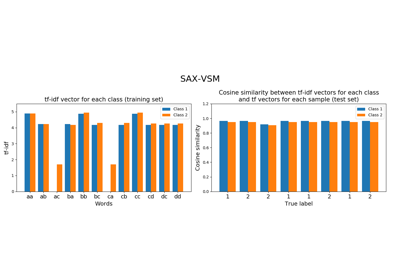pyts.classification.SAXVSM¶
-
class
pyts.classification.SAXVSM(n_bins=4, strategy='quantile', window_size=4, window_step=1, numerosity_reduction=True, use_idf=True, smooth_idf=False, sublinear_tf=True, alphabet=None)[source]¶ Classifier based on SAX-VSM representation and tf-idf statistics.
Time series are first transformed into bag of words using Symbolic Aggregate approXimation (SAX) algorithm followed by a bag-of-words model. Then the classes are transformed into a Vector Space Model (VSM) using term frequencies (tf) and inverse document frequencies (idf).
Parameters: - n_bins : int (default = 4)
The number of bins to produce. It must be between 2 and
min(n_timestamps, 26).- strategy : ‘uniform’, ‘quantile’ or ‘normal’ (default = ‘quantile’)
Strategy used to define the widths of the bins:
- ‘uniform’: All bins in each sample have identical widths
- ‘quantile’: All bins in each sample have the same number of points
- ‘normal’: Bin edges are quantiles from a standard normal distribution
- window_size : int or float (default = 4)
Size of the sliding window (i.e. the size of each word). If float, it represents the percentage of the size of each time series and must be between 0 and 1. The window size will be computed as
ceil(window_size * n_timestamps).- window_step : int or float (default = 1)
Step of the sliding window. If float, it represents the percentage of the size of each time series and must be between 0 and 1. The window step will be computed as
ceil(window_step * n_timestamps).- numerosity_reduction : bool (default = True)
If True, delete sample-wise all but one occurence of back to back identical occurences of the same words.
- use_idf : bool (default = True)
Enable inverse-document-frequency reweighting.
- smooth_idf : bool (default = False)
Smooth idf weights by adding one to document frequencies, as if an extra document was seen containing every term in the collection exactly once. Prevents zero divisions.
- sublinear_tf : bool (default = True)
Apply sublinear tf scaling, i.e. replace tf with 1 + log(tf).
- alphabet : None or array-like, shape = (n_bins,)
Alphabet to use. If None, the first n_bins letters of the Latin alphabet are used.
References
[R329e95927982-1] P. Senin, and S. Malinchik, “SAX-VSM: Interpretable Time Series Classification Using SAX and Vector Space Model”. International Conference on Data Mining, 13, 1175-1180 (2013). Examples
>>> from pyts.classification import SAXVSM >>> from pyts.datasets import load_gunpoint >>> X_train, X_test, y_train, y_test = load_gunpoint(return_X_y=True) >>> clf = SAXVSM(window_size=34, sublinear_tf=False, use_idf=False) >>> clf.fit(X_train, y_train) # doctest: +ELLIPSIS SAXVSM(...) >>> clf.score(X_test, y_test) 0.76
Attributes: - classes_ : array, shape = (n_classes,)
An array of class labels known to the classifier.
- idf_ : array, shape = (n_features,) , or None
The learned idf vector (global term weights) when
use_idf=True, None otherwise.- tfidf_ : array, shape = (n_classes, n_words)
Term-document matrix.
- vocabulary_ : dict
A mapping of feature indices to terms.
Methods
__init__(self[, n_bins, strategy, …])Initialize self. decision_function(self, X)Evaluate the cosine similarity between document-term matrix and X. fit(self, X, y)Fit the model according to the given training data. get_params(self[, deep])Get parameters for this estimator. predict(self, X)Predict the class labels for the provided data. score(self, X, y[, sample_weight])Return the mean accuracy on the given test data and labels. set_params(self, \*\*params)Set the parameters of this estimator. -
__init__(self, n_bins=4, strategy='quantile', window_size=4, window_step=1, numerosity_reduction=True, use_idf=True, smooth_idf=False, sublinear_tf=True, alphabet=None)[source]¶ Initialize self. See help(type(self)) for accurate signature.
-
decision_function(self, X)[source]¶ Evaluate the cosine similarity between document-term matrix and X.
Parameters: - X : array-like, shape (n_samples, n_timestamps)
Test samples.
Returns: - X : array-like, shape (n_samples, n_classes)
osine similarity between the document-term matrix and X.
-
fit(self, X, y)[source]¶ Fit the model according to the given training data.
Parameters: - X : array-like, shape = (n_samples, n_timestamps)
Training vector.
- y : array-like, shape = (n_samples,)
Class labels for each data sample.
Returns: - self : object
-
get_params(self, deep=True)¶ Get parameters for this estimator.
Parameters: - deep : bool, default=True
If True, will return the parameters for this estimator and contained subobjects that are estimators.
Returns: - params : mapping of string to any
Parameter names mapped to their values.
-
predict(self, X)[source]¶ Predict the class labels for the provided data.
Parameters: - X : array-like, shape = (n_samples, n_timestamps)
Test samples.
Returns: - y_pred : array-like, shape = (n_samples,)
Class labels for each data sample.
-
score(self, X, y, sample_weight=None)¶ Return the mean accuracy on the given test data and labels.
In multi-label classification, this is the subset accuracy which is a harsh metric since you require for each sample that each label set be correctly predicted.
Parameters: - X : array-like of shape (n_samples, n_features)
Test samples.
- y : array-like of shape (n_samples,) or (n_samples, n_outputs)
True labels for X.
- sample_weight : array-like of shape (n_samples,), default=None
Sample weights.
Returns: - score : float
Mean accuracy of self.predict(X) wrt. y.
-
set_params(self, **params)¶ Set the parameters of this estimator.
The method works on simple estimators as well as on nested objects (such as pipelines). The latter have parameters of the form
<component>__<parameter>so that it’s possible to update each component of a nested object.Parameters: - **params : dict
Estimator parameters.
Returns: - self : object
Estimator instance.


